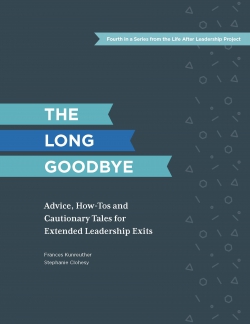Jan
20
2016

Written by Stephanie Clohesy
Download your copy of the report and its tools here.
I have a friend who has a hard time leaving any gathering…a meeting, a party, the restaurant, the office. She stalls, complements the host, promises to reconnect, pulls a thread for a new conversation, sets up the next gathering…anything that averts what is obviously the profound agony of leaving. She has been nicknamed (lovingly) as “Suzy of the Long Goodbye.” Among her friends this behavior is seen as affectionate; it is charming. But it always sets off an alert in me, providing a reminder of other contexts in which some of us have trouble moving on, making our timely exit and leaving something beloved behind us. Often this happens when it is time to leave a leadership role or long-term position. We just don’t feel quite ready to go…it is not the right time…we don’t have everything ready for the finality of the departure, the conditions aren’t perfect and we don’t know where we are going next.
In the social sector a large proportion of executive leaders are baby boomers, generationally heading toward a major life shift. As we get close to the exit door many of us are relieved because we want to dial back the stress and responsibility of our positions; we sense that it IS the right time and in the best interests of the organization (and ourselves) to leave. At the same time we also may be thinking that it might be a good idea to stay, albeit in a different role. We want just a bit more time to be useful to an organization we love. Many of us activate this idea by negotiating for a continuing role as we step down from an executive position. There are times when this suits the needs of the organization and helps allay the fears of board and staff who are worried about their organization’s ability to sustain major leadership change. But it is tricky and not so easy to do. In fact those we interviewed agreed that hanging onto an exiting leader– while also trying to implement a full executive transition– is complex and often impossible.
Frances Kunreuther and I recently completed an extension of our “Life After Leadership” research in which we explored whether and when extending the departure of an exiting leader is a good idea (or not) and how to make it work. The report, “The Long Goodbye: Advice, How Tos and Cautionary Tales for Extended Leadership Exits” is based on interviews with organizational leaders who experienced extended exits as either the exiting leader or the incoming new leader as well as with executive transition consultants. The report updates offers six Key Findings and five Tools to prepare boards and leaders on how to make a feasible decision about an extended exit option.
In a nutshell, the report confirms the current wisdom in the field that says this kind of exit is difficult and likely to fail, and certainly will without appropriate preparation, skills and culture of support.
The six key findings push forward to understand more deeply what it takes to succeed:
- The decision process has to include all the key partners—the organization (represented by the board); the exiting director; and the new incoming leader at a minimum
- An extended exist is ONLY useful if it supports a strong and healthy organization
- Collaboration Skills and Culture are important; both old and new leaders co-existing in the organization need emotional intelligence
- Financial surprises can and will derail extended leadership agreements: planning and transparency are key.
- There is evidence that inside candidates have a better chance at succeeding in an extended leadership situation.
- Optimize the chances of success with careful planning and preparation.
The 5 tools included in the Report will help organizations and leaders to make better decisions about extended exits.
- Tool One “Gaining Insight on Where to Start” will help leaders and their boards to uncover assumptions that are driving their interest in an extended exit.
- Tool Two is an Assessment that is easy to self-administer but thorough in its review of options and possibilities for structuring an extended exit.
- Tools Three, Four and Five help assess the readiness of the Exiting Leader, the Incoming Leader and the Organization (via the Board).
All in all, we were surprised in the process of doing the research by the sobering reflections of those involved. Even those who saw their experiences as a great success were cautionary about others deciding to do the same. In fact, their cautions prompted the creation of the tools as part of the Report. In my consulting practice I see an increasing number of organizations and their funders struggling with the decision about an extended exit and finding and using the best practices to try it. We hope “The Long Goodbye” provides the needed information and guidance.
Download your copy of the report and its tools here.
